Fricourt German Military WW1 Cemetery
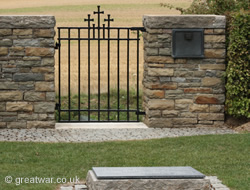
|
The German military cemetery at Fricourt is the resting place for 17,027 German First World War soldiers. They died on the Somme battlefields over the four years of the Great War, from late September 1914, when the German Second Army established a defensive front line in this sector, to the spring and summer Battles of the Somme in 1918.
Approximately 1,000 of the soldiers lying here were killed during the early weeks of the war from late August to the late autumn of 1914, and during the trench warfare from that time through 1915 and up to June 1916.
From the beginning of the British and French Allied Somme offensive of 1st July 1916 to the close of the battle in mid November 1916 approximately 10,000 German soldiers lost their lives on the Somme battlefields.
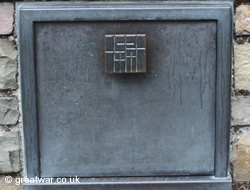
|
A further 6,000 German soldiers were killed during the large-scale German offensive, called the “Kaiserschlacht” by the German Army, from 21st March 1918 and in the battles which followed it up to October 1918.
Origins of Fricourt Cemetery
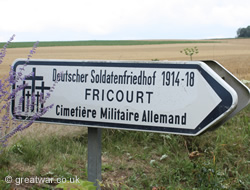
|
A German cemetery close to Fricourt village was begun in 1920 by the French authorities. The battlefields north of the Somme river were gradually cleared of debris and the remains of the soldiers who died in action here. The bodies of German soldiers were brought to Fricourt from some 79 communes in the regions around Bapaume, Albert, Combles, the Ancre valley and Villers-Bretonneux.
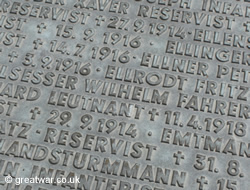
|
It was not until 1929, with the co-operation of the French government, that the German War Graves Agency, the Volksbund Deutsche Gräberfürsorge e.V. (VDK), was able to begin work on the cemetery's landscaping and permanent architectural features.
Work was stopped in 1939 at the outbreak of the Second World War. It was almost 30 years later, following the Franco-German Agreement of 19th July 1966, that the VKD returned to France and again to Fricourt to finish building and landscaping this First World War cemetery.
Identified Graves
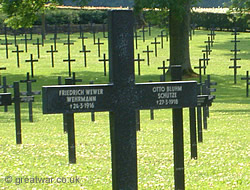
|
Of the 17,000 burials at Fricourt only 5,057 German soldiers have an individual grave. Of these, 114 soldiers are unidentified. These soldiers are generally buried in a double grave at the foot of each cross. The bodies of soldiers were brought together into this cemetery from the surrounding areas and they are not buried in any sequence of time.
The grave in the forefront of the photograph, for example, names Friedrich Wewer who died on 24th March 1916 and Otto Bluhm, who died almost exactly two years later on 27th March 1918.
Manfred von Richthofen
The famous German pilot Baron Manfred von Richthofen, known as the Red Baron, who was shot down and died on 21st April 1918, was first buried in a plot at the civilian cemetery at Bertangles behind the lines southwest of the Somme battlefields. His body was later moved to Fricourt German Military Cemetery but again in 1925 he was exhumed and the body was taken to Berlin for reburial.
Gemeinschaftsgräber - the Communal Graves
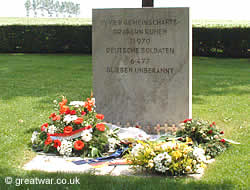
|
The remains of 11,970 soldiers lie in four communal graves (Gemeinschaftsgräber). Of these the names of 6,477 remain unknown.
Names in the Communal Graves
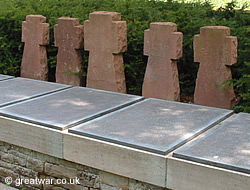
|
The names of those who are known to be buried in the communal graves are inscribed on metal tablets at the rear of the cemetery.
Five Stone Crosses at the Communal Graves
The stone crosses reflect the motif of five crosses which is used by the VDK throughout the German cemeteries and in the VDK logo. The theme of the five crosses originates from the design of a First World War cemetery known as the Vier Grenadier-Grab (Four Grenadiers Grave), which had been built in Poland by the founder of the VDK, Dr. Siegfried Emmo Eulen.
For more information abour the founding of the VDK see our Related Topics below.
Jewish Gravestones
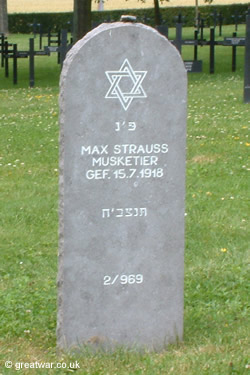
|
The graves of German soldiers of the Jewish faith are marked with a stone marker instead of the cross. Many Jews served in the German Army during the First World War.
Location of Fricourt German Cemetery
Latitude N 50° 0' 16" ; Longitude E 2° 42' 53"
The cemetery is located on the east side of the D147 road from Fricourt to Contalmaison, approximately 1 kilometre north of Fricourt village.
Access
The cemetery is open at all hours. There are steps up to the entrance gate from the road.
Parking
There is no designated parking area as such. The cemetery is located on a country road and visitors are reminded to take care when moving about by parked vehicles and crossing the road to and from the cemetery entrance.
Related Topics
German War Graves
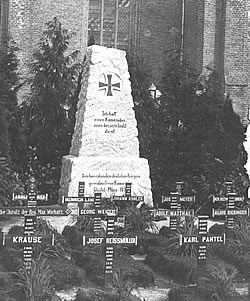
|
German military graves are looked after by the German war graves agency called the Volksbund Deutsche Kriegsgräberfürsorge (VDK). See our page about the German war graves agency, how it came about and the work that it carries out at:
Volksbund Deutsche Kriegsgräberfürsorge (VDK)
German Military Burials in Belgium
See our article about the recovery of German soldiers buried during the war from the battlefields of Flanders:
German Military Burials in Belgium
Acknowledgements
Volksbund Deutsche Kriegsgräberfürsorge (VDK). See our page about the German war graves agency at:
Volksbund Deutsche Kriegsgräberfürsorge (VDK)
(1) Photograph courtesy of the late Bridgeen Fox (Private Collection)
